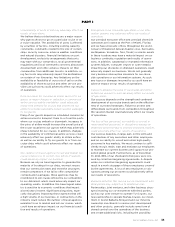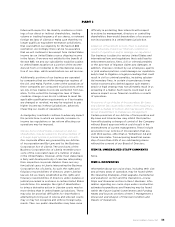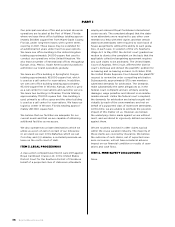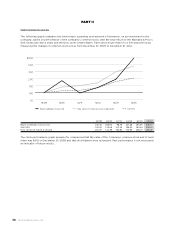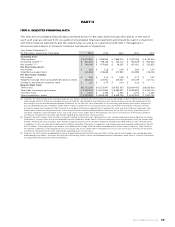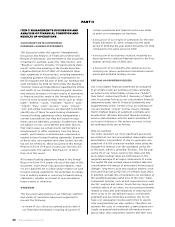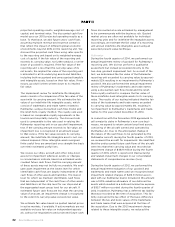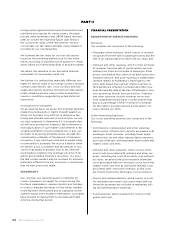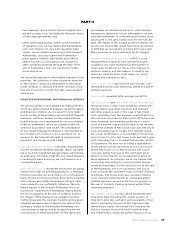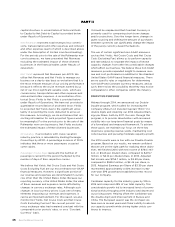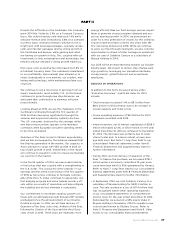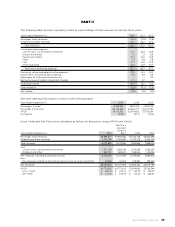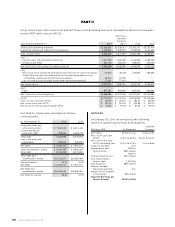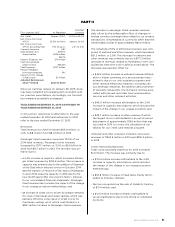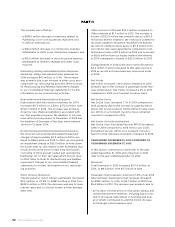Royal Caribbean Cruise Lines 2014 Annual Report Download - page 43
Download and view the complete annual report
Please find page 43 of the 2014 Royal Caribbean Cruise Lines annual report below. You can navigate through the pages in the report by either clicking on the pages listed below, or by using the keyword search tool below to find specific information within the annual report.
42 Royal Caribbean Cruises Ltd.
PART II
projected operating results, weighted-average cost of
capital, and terminal value. The discounted cash flow
model uses our 2015 projected operating results as a
base. To that base, we add future years’ cash flows
assuming multiple revenue and expense scenarios
that reflect the impact of different global economic
environments beyond 2015 on the reporting unit. We
discount the projected cash flows using rates specific
to the reporting unit based on its weighted-average
cost of capital. If the fair value of the reporting unit
exceeds its carrying value, no further analysis or write-
down of goodwill is required. If the fair value of the
reporting unit is less than the carrying value of its
net assets, the implied fair value of the reporting unit
is allocated to all its underlying assets and liabilities,
including both recognized and unrecognized tangible
and intangible assets, based on their fair value. If nec-
essary, goodwill is then written down to its implied
fair value.
The impairment review for indefinite-life intangible
assets consists of a comparison of the fair value of the
asset with its carrying amount. We estimate the fair
value of our indefinite-life intangible assets, which
consist of trademarks and trade names related to
Pullmantur, using a discounted cash flow model and
the relief-from-royalty method. The royalty rate used
is based on comparable royalty agreements in the
tourism and hospitality industry. The discount rate
used is comparable to the rate used in valuing the
Pullmantur reporting unit in our goodwill impairment
test. If the carrying amount exceeds its fair value, an
impairment loss is recognized in an amount equal
to that excess. If the fair value exceeds its carrying
amount, the indefinite-life intangible asset is not con-
sidered impaired. Other intangible assets assigned
finite useful lives are amortized on a straight-line basis
over their estimated useful lives.
We review our ships, aircraft and other long-lived
assets for impairment whenever events or changes
in circumstances indicate, based on estimated undis-
counted future cash flows, that the carrying amount
of these assets may not be fully recoverable. We eval-
uate asset impairment at the lowest level for which
identifiable cash flows are largely independent of the
cash flows of other assets and liabilities. The lowest
level for which we maintain identifiable cash flows
that are independent of the cash flows of other assets
and liabilities is at the ship level for our ships and at
the aggregated asset group level for our aircraft. If
estimated future cash flows are less than the carrying
value of an asset, an impairment charge is recognized
to the extent its carrying value exceeds fair value.
We estimate fair value based on quoted market prices
in active markets, if available. If active markets are not
available we base fair value on independent apprais-
als, sales price negotiations and projected future cash
flows discounted at a rate estimated by management
to be commensurate with the business risk. Quoted
market prices are often not available for individual
reporting units and for indefinite-life intangible assets.
Accordingly, we estimate the fair value of a reporting
unit and an indefinite-life intangible asset using an
expected present value technique.
Pullmantur
During the fourth quarter of 2014, we performed our
annual impairment review of goodwill for Pullmantur’s
reporting unit. We did not perform a qualitative
assessment but instead proceeded directly to the
two-step goodwill impairment test. As a result of the
test, we determined the fair value of the Pullmantur
reporting unit exceeded its carrying value by approxi-
mately 52% resulting in no impairment to Pullmantur’s
goodwill. We also performed the annual impairment
review of Pullmantur’s trademarks and trade names
using a discounted cash flow model and the relief-
from-royalty method to compare the fair value of
these indefinite-lived intangible assets to its carrying
value. The results of our testing indicated that the fair
value of the trademarks and trade names exceeded
its carrying value by approximately 4%, resulting in
no impairment to Pullmantur’s trademarks and trade-
names for the year ended December 31, 2014.
In connection with the December 2013 agreement to
sell a majority stake in Pullmantur’s non-core busi-
nesses, we agreed to retain certain long-lived assets,
consisting of the aircraft owned and operated by
Pullmantur Air. Due to the anticipated change in
the nature of the cash flows to be generated by the
Pullmantur aircraft, during the fourth quarter of 2013,
we reviewed the aircraft for impairment. We identified
that the undiscounted future cash flows of the aircraft
were less than their carrying value and recorded an
impairment charge of $48.9 million during the fourth
quarter of 2013, which is reported in Restructuring
and related impairment charges in our consolidated
statements of comprehensive income (loss).
During the fourth quarter of 2012, we performed the
annual impairment evaluation of our goodwill and
trademarks and trade names and we recognized total
impairment related charges of $413.9 million associ-
ated with our Pullmantur brand. Included in this amount
was a 100% valuation allowance of our deferred tax
assets which resulted in a deferred income tax expense
of $33.7 million recorded during the fourth quarter of
2012. In addition, Pullmantur has a deferred tax liability
that was recorded at the time of acquisition. This lia-
bility represents the tax effect of the basis difference
between the tax and book values of the trademarks
and trade names that were acquired at the time of
the acquisition. Due to the 2012 impairment charge
related to these intangible assets, we reduced the



